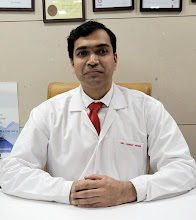What is Retina?
The retina is the innermost layer of the eye, and it features many light-sensitive photoreceptor cells.
These cells detect light and convert it into electrical signals
Retinal tear
A retinal tear happens when there is a tear or hole in the retina. This typically occurs when the vitreous,
which is a jelly-like substance in the eye, attaches to the retina and pulls hard enough to tear it. This can
happen when the vitreous detaches as part of the aging process, or it can result from trauma.
Retinal tears can cause blurry vision, the sudden onset of floaters, or flashes of light.
It is important for people to receive treatment for a retinal tear, as it may result in retinal detachment.
This is a more serious condition that affects vision.
Retinal detachment
Retinal detachment occurs when a buildup of fluid, which usually enters through a retinal tear, causes
the retina to detach from the choroid, which is the eye layer that provides it with oxygen and nutrients.
Retinal detachment is a medical emergency that, without treatment, may lead to permanent vision loss.
Retinopathy
Retinopathy results from damage to the blood vessels at the back of the eye, which causes fluid to leak. This accumulation of fluid can affect the retina and result in changes to vision. Conditions that can cause retinopathy include diabetes, high blood pressure, anemia etc
Diabetic retinopathy i.e diabetic eye disease is a common complication of diabetes, with evidence suggesting that it is a leading cause of blindness among adults in the India
Epiretinal membranes
Epiretinal membranes (ERMs), also called macular puckers or cellophane maculopathy, make up a thin layer that forms on the retina’s inner surface. It is usually scar tissue from a medical condition or injury. ERMs often do not cause symptoms, except when they affect the macula or the center of the retina, which is important in perceiving visual details and features. A person may notice distortion of their central vision.
Macular hole
Similar to retinal tears, macular holes are small breaks in the macula that occur due to an unusual pulling between the vitreous and the retina. Aging is the most common cause of macular holes. Eye injuries may also result in macular holes.
Macular degeneration
Because macular degeneration is more common among older adults, eye doctors usually call it age-related macular degeneration (AMD). With this condition, the macula deteriorates and causes distorted central vision, which may worsen over time and cause permanent vision loss. It is a common cause of loss of vision in elderly
Retinitis
Retinitis refers to the inflammation of the retina. It usually results from viruses and bacteria. For example, Lyme disease, syphilis, and Dengue fever may cause retinitis. Autoimmune conditions, such as Behçet’s disease and lupus, may also cause this condition.
Retinitis pigmentosa
Retinitis pigmentosa is a rare genetic degenerative condition that causes a breakdown and loss of cells in the retina. This can cause a progressive loss of vision.
Macular edema
Macular edema is a condition that occurs due to fluids building up in the macula, causing it to swell. Several conditions can cause macular edema, including AMD, diabetes, and retinal vein occlusion.
Retinal vein occlusion
Retinal vein occlusion, or eye stroke, is a blood vessel disorder wherein branches of the retinal vein become occluded, causing fluid and blood to spill onto the retina. The blockage cuts off circulation, which can cause nerve cells to die, leading to vision loss.
Diagnosis
To examine and diagnose eye conditions such as retinal disorders, ophthalmologists will typically first ask about the person’s medical history. This allows them to look for factors that may affect their vision, such as underlying conditions. They will then perform a comprehensive eye exam with a particular focus on the retina and the macula. They will use a special instrument called an ophthalmoscope to investigate the inside of the eye.
The ophthalmologist may use eye drops to widen (dilate) the pupil to see the inner eye better. They may also request an eye ultrasound and give numbing eye drops to prevent discomfort as they scan the eye. Ophthalmologists may also take images of the retina using optical coherence tomography (OCT). They may also request dye tests such as fluorescein angiography to look for leakage in the blood vessels.
Treatment
The goals of treatment will be to preserve and restore vision or to prevent and slow down the damage in the retina.
Treatment for retinal disorders varies depending on the type and extent of the condition. Options may range from medications and vitamins to injections, surgery, and laser treatments.
An individual’s eye specialist will discuss the most suitable treatment options for their condition.


No comments:
Post a Comment